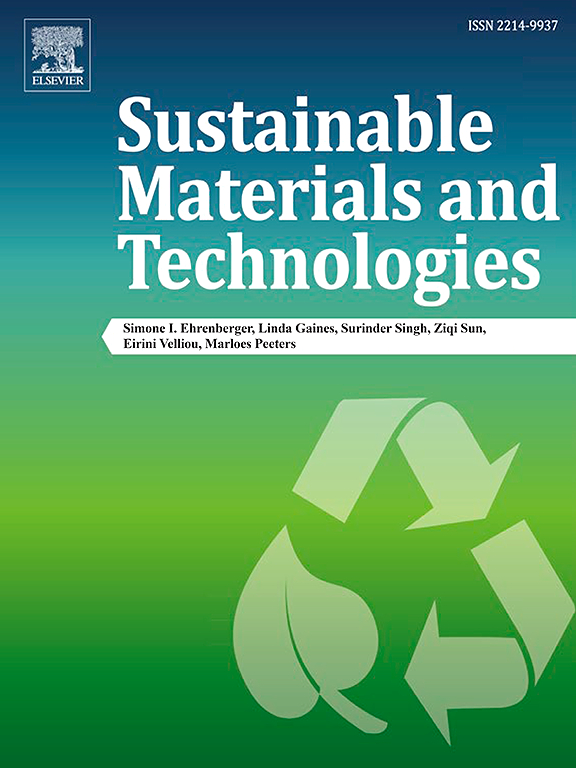Effect of different surface modification methods of small particle size recycled rubber powder on mechanical properties of 3D printed concrete
IF 8.6
2区 工程技术
Q1 ENERGY & FUELS
引用次数: 0
Abstract
Due to the relatively weak adhesion between rubber and the concrete matrix in 3D printed rubber concrete, the mechanical properties of the concrete undergo considerable losses. This study employs solutions of varying concentrations to treat the surface of small particle size rubber (SPSR) through an immersion method, aiming to reduce its hydrophobicity and enhance the strength of 3D printed small particle size rubber concrete (3DP-SPSRC). The mechanical properties of 3DP-SPSRC modified with three types of solutions are tested and verified that all three solutions can improve the mechanical properties of the concrete to varying degrees. Among them, the concentrations of the three solutions that yield the best modification effects are as follows: 15 % sodium hydroxide solution (NaOH) for modification, 10 % sulfuric acid solution (H2SO4) for modification, and 5 % potassium permanganate solution (KMnO4) for modification. The improvement range of compressive and flexural strength of 3DP-SPSRC by them is between 4.3 % and 35.93 %. Among the three solutions evaluated, 5 % KMnO4 treatment demonstrates the most significant improvement in mechanical strength. Through comparative analysis of the activation index and contact angle measurements of SPSR before and after modification, it is evident that both parameters exhibit a marked reduction post-treatment, which indicates that the modification processes employed effectively enhance the hydrophilic properties of the rubber. Notably, 5 % KMnO4 modified rubber displays superior hydrophilicity compared to the other treatment conditions. Based on SEM, the micro - morphology of the modified rubber is observed and analyzed. The workability and extrudability tests demonstrate that the modified 3DP-SPSRC could be well-suited for the self-developed 3D concrete printer, and the interlayer bond strength is significantly increased by 46.63 %. In this study, recycled rubber powder made from waste tires is added to concrete and applied in 3D printing technology, which alleviates the environmental pressure caused by waste tires. The methods of surface modification of SPSR are explored and verified the feasibility of surface - modifying SPSR to improve the mechanical properties of 3D - printed rubber concrete

小颗粒再生胶粉不同表面改性方法对3D打印混凝土力学性能的影响
在3D打印橡胶混凝土中,由于橡胶与混凝土基体的附着力较弱,混凝土的力学性能损失较大。本研究采用不同浓度的溶液浸泡法对小粒径橡胶(SPSR)表面进行处理,旨在降低其疏水性,提高3D打印小粒径橡胶混凝土(3D - spsrc)的强度。通过对三种改性溶液对3d - spsrc的力学性能进行测试,验证了三种改性溶液均能不同程度地改善混凝土的力学性能。其中,改性效果最好的三种溶液浓度分别为:15%氢氧化钠溶液(NaOH)改性、10%硫酸溶液(H2SO4)改性、5%高锰酸钾溶液(KMnO4)改性。它们对3d - spsrc抗压和抗弯强度的改善幅度在4.3% ~ 35.93%之间。在三种处理方案中,5% KMnO4处理的机械强度提高最为显著。通过对改性前后SPSR的活化指数和接触角测量结果的对比分析,可以看出,处理后SPSR的活化指数和接触角都有明显的降低,表明改性工艺有效地提高了橡胶的亲水性。值得注意的是,5% KMnO4改性橡胶的亲水性优于其他处理条件。利用扫描电镜对改性橡胶的微观形貌进行了观察和分析。工作性和挤压性试验表明,改性后的3D - spsrc可以很好地用于自行研制的3D混凝土打印机,层间粘结强度显著提高46.63%。本研究将废旧轮胎制成的再生胶粉加入到混凝土中,并应用于3D打印技术,缓解了废旧轮胎带来的环境压力。探索了SPSR的表面改性方法,验证了表面改性SPSR改善3D打印橡胶混凝土力学性能的可行性
本文章由计算机程序翻译,如有差异,请以英文原文为准。
求助全文
约1分钟内获得全文
求助全文
来源期刊

Sustainable Materials and Technologies
Energy-Renewable Energy, Sustainability and the Environment
CiteScore
13.40
自引率
4.20%
发文量
158
审稿时长
45 days
期刊介绍:
Sustainable Materials and Technologies (SM&T), an international, cross-disciplinary, fully open access journal published by Elsevier, focuses on original full-length research articles and reviews. It covers applied or fundamental science of nano-, micro-, meso-, and macro-scale aspects of materials and technologies for sustainable development. SM&T gives special attention to contributions that bridge the knowledge gap between materials and system designs.
 求助内容:
求助内容: 应助结果提醒方式:
应助结果提醒方式:


